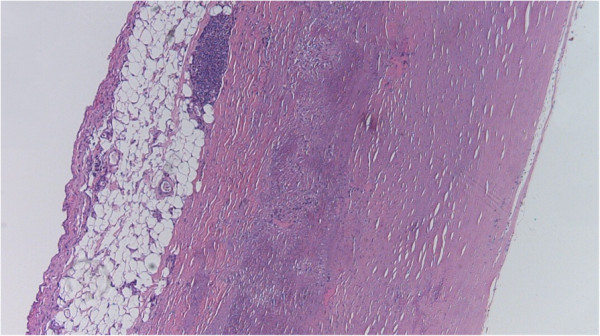Playlist
Show Playlist
Hide Playlist
Atherosclerosis: Pathogenesis
-
Slides Pathogenesis of Plaque Formation.pdf
-
Reference List Pathology.pdf
-
Download Lecture Overview
00:00 Okay, so it begins with endothelial injury. 00:05 And I would actually say begins with endothelial cell dysfunction. 00:09 Again, we are not losing endothelial in the vast majority of cases. 00:13 So hyperlipidemia can cause endothelial dysfunction hypertension, smoking. 00:19 Other hemodynamic factors, as we've seen in a previous session where flow characteristics at bifurcation spots will affect endothelial health and well being. 00:30 Homocysteine, a metabolic factor in certain people do you have hyperhomocysteinemia. 00:36 Certain toxins, including those that occur in cigarette smoke. 00:41 Certain microbial infections, and immune injury, all these will grow up, drive endothelial cell dysfunction, making those endothelial cells more procoagulant, pro-inflammatory, pro-sticky, they're going to be recruiting inflammation. 00:58 Okay, so with our initial endothelial cell dysfunction, we began to accumulate monocytes that will eventually crawl across into the sub endothelial media that are intima and become macrophages. 01:14 We also will have platelet adhesion, as a result of the endothelial cell dysfunction. 01:23 We'll see increased permeability as resulted in endothelia cell dysfunction, we'll see leukocyte, monocyte and T-cell, adhesion and emigration and we'll see platelet adhesion, all of these things are happening as a result of that initial dysfunction of the endothelium. 01:42 Once those cells begin being recruited into the intima, you see them there. 01:47 So the kind of the irregular blobs or macrophages that have crawled across originally started as monocytes, the rounder cells are lymphocytes. 01:56 They are going to be major drivers, they're going to elaborate now that they're there in this space, they will elaborate various cytokines that will recruit and activate smooth muscle cells coming from a couple of different locations. 02:10 As we will see in a subsequent slide. 02:13 That ongoing endothelial cell dysfunction causes increased permeability, and all the cholesterol it's in the circulation, now can get across into that intima. 02:25 That cholesterol that gets across can be modified, and will drive the activation, further activation of macrophages in smooth muscle cells. 02:34 And they will also accumulate cholesterol to become foam cells. 02:39 Here's an example of that. 02:41 So this is the larger box is a photo micrograph of an earlier, early fatty streak, the earliest lipid accumulation that occurs in a pre kind of atherosclerotic lesion. 02:58 The gross image in the upper right hand corner just is showing you that yellowness, that's due to the lipid accumulation, the cholesterol accumulation. 03:05 The photo micrograph is showing you in brown endothelial cells, so they're on the surface, they're still very much there. 03:12 The cleared out areas underneath represent foamy macrophages. 03:17 Macrophages that started as monocytes got recruited to this area because there is increased adhesiveness of the endothelial cells because they were dysfunctional. 03:27 And they've crawled across instead of shop and as the vessels become also more permeable to all the cholesterol that's in the lumen. 03:36 These macrophages take that up. 03:38 They oxidize it, and that oxidize low density lipoprotein cholesterol is going to be a major driver of subsequent macrophage activation. 03:51 So, as we mature the plaque, the cytokines produced by the activated macrophages and the T-cells will drive smooth muscle cell proliferation. 04:01 The deposition of increased extracellular matrix, that's our fibrous cap that's coming from those inflammatory cells driving the smooth muscle cells to proliferate and make matrix. 04:13 As part of the process, this is in fact going to be the normal production of or the fully anticipated production of, of angiogenic factors. 04:25 So this is going to behave as if it were a healing wound even though there's no wound, there's just a dysfunctional endothelium. 04:35 We will, it because the vessels are leaky and the endothelium is permeable, we will begin to get a significant accumulation of extracellular lipid. 04:44 Not only within cells but also as pools of lipid debris. 04:48 And because of this intense inflammatory milieu, the environment in there is actually fairly toxic, and we will induce a lot of necrosis so there's going to be necrotic debris. 05:01 So we've got our atherosclerotic cap, our fibrous cap of smooth muscle cells and matrix and our atheromatous core of cholesterol in necrotic debris.
About the Lecture
The lecture Atherosclerosis: Pathogenesis by Richard Mitchell, MD, PhD is from the course Atherosclerosis.
Included Quiz Questions
What is a common promoter of endothelial dysfunction?
- Smoking
- Alcohol
- Stress
- Exercise
- Swimming
What is a characteristic cell seen in an atherosclerotic plaque?
- Foamy macrophages
- Giant lymphocytes
- Hyperchromatic macrophages
- Prominent eosinophils
- Finely granular macrophages
What is an important step in atherosclerotic plaque maturation?
- Extracellular matrix (ECM) deposition
- Endothelial dysfunction
- Migration of macrophages
- Accumulation of cholesterol
- Increased permeability
Customer reviews
5,0 of 5 stars
| 5 Stars |
|
5 |
| 4 Stars |
|
0 |
| 3 Stars |
|
0 |
| 2 Stars |
|
0 |
| 1 Star |
|
0 |




